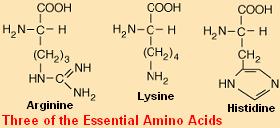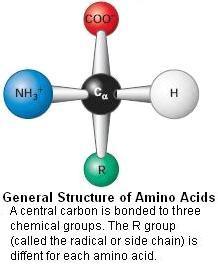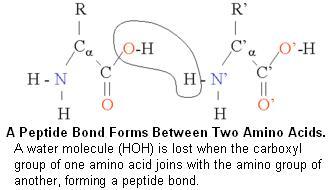| |
Proteins are made of amino acids
Proteins are constructed of amino acid molecules. Amino acids contain the elements carbon, hydrogen, oxygen and nitrogen. Certain amino acids also have sulfur atoms, phosphorous, or other trace elements such as iron or copper.
In proteins, amino acids are linked together like units on a chain. There are 20 different amino acids. Just as the letters of our alphabet can be arranged in many ways to make words of different lengths, so too amino acids can be linked together differently to form many thousands of different proteins. Each protein has its own unique chain of amino acids, and each protein has its own purpose in a living thing.

Amino acids contain the elements carbon, hydrogen, oxygen and nitrogen. Certain amino acids also have sulfur atoms, phosphorous, or other trace elements such as iron or copper.
Radicals Make Each Amino Acid Different
Each amino acid contains a central carbon bonded to four main groups: an amino group (-NH3+), a carboxyl group (-COO-), a radical group (-R), and a hydrogen atom. The radical group (also called a side chain) is where each amino acid differs from the others - it is the radical group that determines the amino acids properties.

|
|
Peptide Bonds Join Amino Acids Together
The removal of a water molecule links amino acids to form a protein. The link is called a peptide bond.

Peptide bonds provide rigidity to the protein.

Proteins Fold Up After Synthesis
Each protein contorts into its own native state, a three dimensional structure determined by the amino acids in its chain. The biological function of the protein is very dependent on its shape.
A proteins function is better understood when its shape is known. Structural biology uses techniques like X-ray crystallography or NMR spectroscopy to determine the structure of proteins. Solved structures can be deposited in the Protein Data Bank (PDB), a free resource containing thousands of proteins.
Proteins require a minimum of about 40 amino acids, but sizes range up to several thousand in multi-functional or structural proteins. The average length is about 300 amino acids. Also, very large aggregates can be formed from protein subunits.
|
|